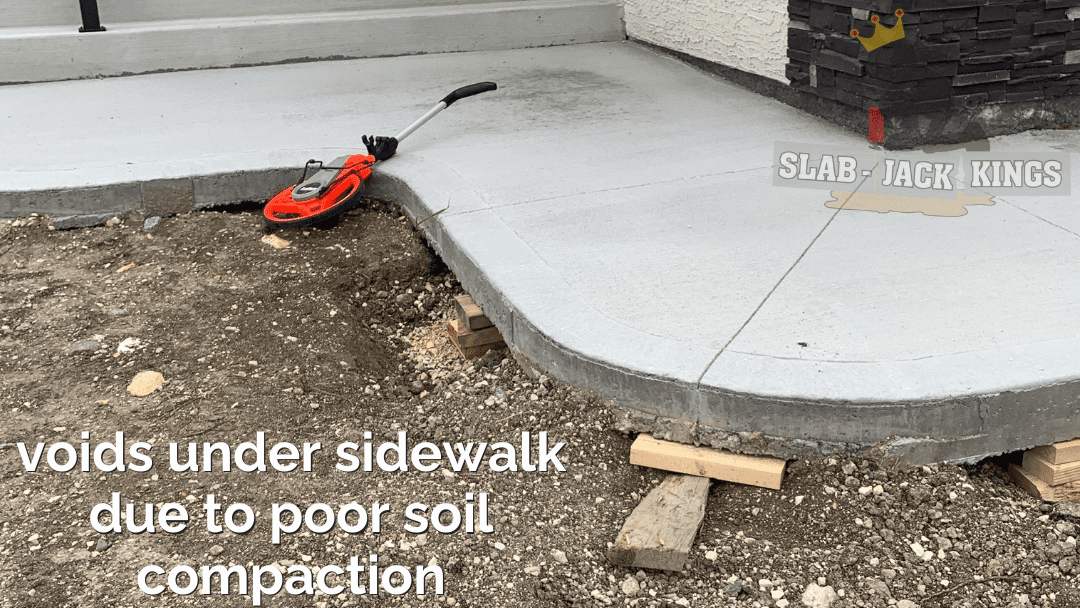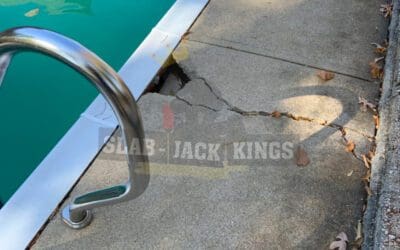Learn essential tips for maintaining your concrete after lifting. Our comprehensive guide covers the best practices to ensure long-lasting, durable concrete slabs. Get expert advice from Slab-Jack Kings.

You’re not alone if you’ve ever noticed sunken concrete on your property. Many homeowners encounter this issue, which can impact safety and aesthetics. This comprehensive guide will delve into the various causes of sunken concrete and provide valuable insights on prevention and solutions to safeguard your property investment.
Common Causes of Sunken Concrete
- Soil Erosion: Soil erosion is one of the primary culprits behind sunken concrete. Over time, heavy rainfall and runoff can wash away the soil beneath your concrete surfaces. This erosion weakens the foundation, leading to uneven surfaces and cracks in your concrete.
- Poor Compaction During Construction: The quality of construction plays a crucial role in preventing concrete settlement. Inadequate soil compaction during initial construction can create voids beneath the concrete, causing it to sink over time. Proper compaction is vital to avoid future settlement issues.
- Water Infiltration and Drainage Issues: Water infiltration poses a significant threat to concrete. Prolonged exposure to moisture can weaken the concrete’s integrity, leading to settlement problems. Effective drainage systems are essential to maintain concrete stability and subbase integrity.
- Tree Roots and Vegetation Growth: The growth of tree roots and vegetation near your concrete slabs can contribute to settlement. Tree roots can exert significant pressure on the concrete, causing it to sink or crack. Managing root pressure through root barriers and innovative landscaping practices can help prevent damage.
- Soil Consolidation Over Time: Natural soil consolidation is a gradual process where soil settles and compacts. While this is a natural occurrence, it can result in concrete sinking if not appropriately managed. Monitoring soil consolidation and taking preventive measures are vital to maintaining concrete stability.
- Critters: Small animals, such as moles or groundhogs, can create voids underneath concrete by digging tunnels. These voids remove support from the slab, leading to sinking and instability.


Preventing Sunken Concrete
To prevent sunken concrete, consider the following measures:
- Proper Site Preparation and Compaction: Strong foundations are essential for long-term concrete stability. Ensure correct site preparation and compaction during construction to prevent future issues.
- Adequate Drainage Systems: Install effective drainage solutions and direct water away from your concrete slabs to maintain their integrity. Regular grading and maintenance are crucial.
- Managing Tree Roots and Vegetation: Implement root barriers and smart landscaping practices to protect your concrete from root-related damage while preserving your greenery.
- Routine Inspections and Maintenance: Regular inspections help identify issues early and allow for prompt action. Implement a DIY inspection checklist to monitor your concrete’s condition proactively.
- Proactive Techniques like Polyurethane Foam Injection: Explore proactive techniques like polyurethane foam injection for concrete void filling and stabilizing to provide long-lasting preventative measures to settlement issues.
Self-Assessment Guide
This self-assessment guide helps homeowners identify potential concrete problems. If you find issues beyond minor cosmetic imperfections, consult with professionals (Slab-Jack Kings!) for a comprehensive evaluation and appropriate solutions. Here’s the simple self-assessment guide to help homeowners evaluate the condition of their concrete surfaces to determine when action is necessary:
Self-Assessment Guide for Concrete Slabs
1. Surface Inspection:
– Examine the entire concrete surface for noticeable cracks or fissures, and note their size and location.
– Check for areas where the concrete appears uneven, sunken, or raised. Walk carefully to detect any unevenness.
2. Water Drainage:
– Observe how water drains on the concrete. Ensure that water flows away from the surface and doesn’t accumulate.
– Inspect nearby drainage systems (e.g., gutters, downspouts) to confirm they’re not causing water pooling.
3. Vegetation and Tree Roots:
– Inspect the proximity of trees and vegetation to the concrete. Look for signs of root intrusion or pressure.
– Note visible cracks or uplifts caused by tree roots.
4. Visual Discoloration:
– Check the concrete’s color and surface texture for unusual discolorations or rough patches.
– Note any areas that appear significantly different from the rest of the surface.
5. Safety Hazards:
– Look for tripping hazards, especially on walking or driving surfaces.
– Identify loose or dislodged concrete pieces that could pose safety risks.
6. Overall Stability:
– Assess the stability and firmness of the concrete as you walk across it.
– Pay attention to areas that feel hollow or give way, and listen for unusual sounds or vibrations.
7. Crack Width Measurement:
– Measure the width of any cracks you find using a ruler or measuring tape. Record these measurements.
8. Photographic Documentation:
– Take clear photographs of areas with concerns, cracks, or noticeable issues. These photos can be useful for professional consultations.
9. Maintenance History:
– Review the maintenance history of the concrete, including past repairs or modifications, for context.
10. Professional Consultation:
– If you discover significant cracks, substantial sinking, or structural concerns during your assessment, consider seeking the opinion of concrete experts or professionals for a thorough evaluation and solutions.


DIY Prevention Methods:
Empower yourself with proactive DIY-friendly solutions to prevent concrete settlement and reduce the risk of minor issues. Implementing small yet impactful steps such as regular surface cleaning, sealing cracks, and improving drainage can help maintain your concrete’s integrity. By taking these measures, you can play an active role in preserving your concrete surfaces and preventing them from sinking or deteriorating.
When to Seek Professional Help:
Recognizing when it’s time to enlist the expertise of professionals is essential in effectively addressing complex settlement problems. If you observe significant concrete sinking, extensive cracks, or structural issues beyond minor cosmetic imperfections, it’s advisable to seek the assistance of experienced concrete lifting experts. Their specialized knowledge and advanced techniques can provide comprehensive solutions to ensure the safety and longevity of your concrete slabs.
The Long-term Cost Savings:
Investing in prevention pays off in the long run, saving you on costly repairs and maintenance expenses.
Common Causes Of Sunken Concrete Can Be Prevented
Visit our Facebook and Instagram pages to view more completed projects.
Related Posts
How to Fix a Sinking Concrete Slab With Polyurethane Foam
Discover the efficient and cost-effective method of fixing sinking concrete slabs with foam. Learn the process, benefits, and why it’s the preferred solution.
Tips to Prevent and How to Repair Cracks in Concrete Driveways
Learn how to prevent cracks in concrete driveways with our expert tips. Protect your investment and maintain the longevity of your driveway with proactive maintenance strategies.
Rescuing a Sinking Basement Floor: The Slab-Jack Kings Solution
Worried about a sinking basement floor? Learn how Slab-Jack Kings can quickly lift and level your basement floor with minimal disruption and cost.
My Pool Deck Sounds Hollow! What should I do?
My Pool Deck Sounds Hollow Why Are Cracks Forming In My Pool Deck? Notice cracks forming in your pool deck? Have a baseball bat lying around? Some simple ways to find potential dangerous voids beneath pool decks starts with checking for cracks, critter-made holes...
Polyurethane Concrete Lifting Cost – Why Choose Foam vs Mud?
Discover the efficient, cost-effective method to fix sinking concrete slabs with foam. Learn the process, benefits, and why it’s preferred.
What CAN’T Be Raised With Foam or Mud?
Can All Concrete Be Restored? When is a slab too damaged to raise vs replace it? What CAN'T Be Restored With Foam Jacking or Mudjacking 1. Precast or hollow cast steps and staircases: Unfortunately we aren’t able to lift staircases like this. If you cannot see a slab...
How to Maintain Your Concrete After a Lift: The Exterior Post-Lift Maintenance Guide
How to Maintain Your Concrete After a Lift: The Exterior Post-Lift Maintenance Guide Raising the Surrounding Grade - Imperative! After an exterior concrete lifting job, the customer is responsible for raising any of the adjacent...
My Concrete Patio Is Sinking. What Do I Need To Do?
"My Concrete Patio Is Sinking." You need to contact the concrete lifting, foam jacking specialists-Slab-Jack Kings! Raise, level and stabilize your slab vs costly replacement. Save up to 85% of the replacement cost and use your patio again within a few hours! Before:...
Lifting a Radiant Heated Concrete Floor: In the Shop
Lifting a Radiant Heated Concrete Floor: Shop Floor Edition. Before: The west side of this shop floor with in-floor heat pipes had water draining towards the south west wall. This was causing major issues for this farmer because they were using this area for heavy...










